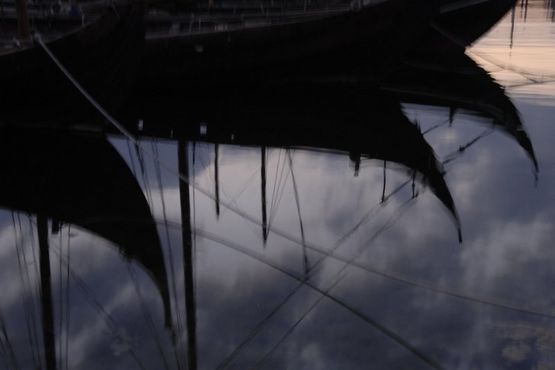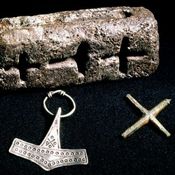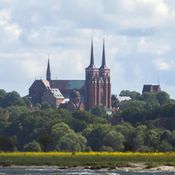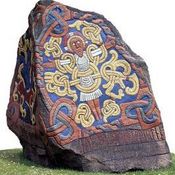
The Nordic gods
The Vikings believed in many gods and goddesses, all of whom had different abilities. The gods could help in war, hunting or fishing. They ruled the weather and caused the grain in the field to grow. They also controlled love and could provide many children.
King of the gods
Odin was the king of the gods. He only had one eye, yet could see everything. He was the god of war, magic, wisdom and runes. When Odin visited the world of men Midgard, he looked like a very old man with only one eye.
The god of war Tor
Tor was the son of Odin. He was god of war and fertility. His hallmark was a magic hammer, named Mjølner, which he used in battle. As he drove across the sky in his magical chariot pressed by goats, he created thunder and lightening. In this way he provided rain for the peasants. Tor was the most popular god. Many Vikings wore a small hammer as jewelery or amulets.
Fertility gods
Frej and Freja were siblings. Frej made sure that the grain grew and that the livestock reproduced. Freja was the goddess of love and fertility. She made sure the women could get pregnant.
Valhalla
The Giants lived in a kind of underworld and symbolized the evil and chaotic world. The gods had to fight against them all the time. When a warrior died in battle, he came to the kingdom of the gods, Asgard. There he lived in Odin's hall, Valhalla. He lived as if in paradise until the day Ragnarok came. Ragnarok was the end of the world and all dead warriors had to fight the gods against the Giants in a major battle.
Midgard worm and Fenris wolf
Some of the most dangerous creatures in the gods world were the Midgard worm and the Fenris wolf.
The midworm was a giant sea snake that extended all the way around the earth. The Fenris wolf was a big wolf. The gods had bound it in a cave so that it could not spread death and destruction. At Ragnarok the Fenris wolf would break free and take part in the battle with the Midgard worm.



Christianity comes to Denmark
At the beginning of the Viking period, people in the Nordic Countries believed in the Nordic gods. But gradually the Viking became Christians. The Vikings became acquainted with Christianity abroad, or by way of the monks who travelled to the Nordic Countries as missionaries.
The first monks came to Denmark in the 8th and 9th centuries. Ansgar is the most well known of these. At first the missionaries had no great success, but they did contribute to spreading knowledge of Christianity. As a consequence, it was easier for later missionaries to convince the Vikings that the Christian God, The White Christ, was the strongest.
Many Vikings encountered Christianity abroad. They saw that the Christian countries were large and strong and had many riches in their stone churches.
It was often a requirement at foreign trading places that merchants was Christian. Otherwise they couldn't trade there. Consequently, some Viking merchants let themselves be baptised. Christianity was permitted at the Danish trading places, as perhaps was the building of churches which made it was easier to attract Christian merchants to Denmark from abroad.
Whether the Vikings became Christians at once, just because they had been baptised abroad, seems doubtful. Many were probably persuaded because fine white cloth was given as a gift at the baptism.
There is a story concerning a Viking representative to the Frankish court who let himself be baptised. Many people were to be baptised that day and when it came to his turn there was no more white cloth. He was, therefore, given something much poorer and coarser. He protested vociferously – he had now been baptised 20 times, and each time he had been given a fine set of white clothes! Who were these misers who baptised him now?
The Christian Harald Bluetooth
The first Danish king to convert to Christianity was Harold Bluetooth. The monk Widukind writes in his Saxon Chronicle that Harold was baptised around AD 965. In order to convert him, it was necessary for a monk called Poppo to endure an ordeal by fire. That is, Poppo had to carry a piece of red-hot iron in his hands. If he was then able to show that he had not suffered burns, this was an indication that the Christian God was the strongest.
By the end of the Viking Age, around AD 1050, most Danes had become Christians. Stone churches was constructed and there were bishops and priests in many towns. Many of the priests came from England as did many of the builders brought to Denmark to build the churches. Some of the important church towns at that time were Ribe, Odense, Roskilde and Lund.Even though Denmark was then a Christian country, many people also continued to worship the Nordic gods.
Fact: There are still people today who believe in gnomes, elves, subterranean spirits and holy trees. Perhaps these are surviving vestiges of the old beliefs. Some Scandinavians practise the Asa-belief, which woship the old Nordic goods and customs.